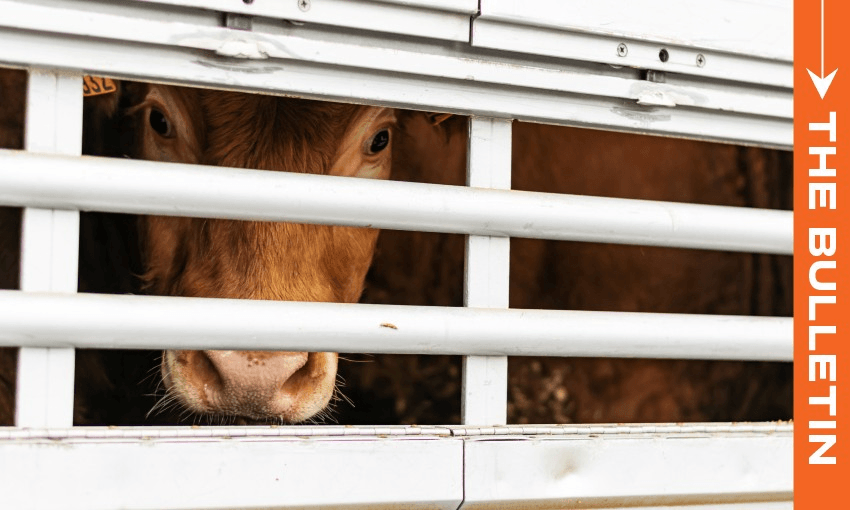The practice was only outlawed last year, but could be scrapped by 2025. In this extract from The Bulletin, Stewart Sowman-Lund asks: why?
To receive The Bulletin in full each weekday, sign up here.
Get ready to have your say
New Zealand was the first country to implement a ban on live animal exports, but it may be short-lived. Public consultation on its return is expected to begin later this month. In late June, the associate agriculture minister Andrew Hoggard announced that the government hoped to introduce legislation in the new year to see the practice reintroduced, fulfilling a promise found in the coalition agreement between National and Act. A spokesperson for Hoggard told The Bulletin that the consultation document was in the final stages of development and would be released following cabinet consideration. The broad term “live export” is a bit misleading. Exports of animals for the purpose of slaughter have been outlawed in New Zealand since the late-2000s. However, until last year’s ban, livestock could still be shipped overseas for breeding or milking purposes, primarily cows being sent to China. And, as 1News explains here, we do still export smaller animals like bees and chickens.
A short-lived ban
The ban on live exports may only have been in force since last year, but like much in politics, a change of government meant a reversal was almost certain (Labour has pledged to reverse the reversal if it returns to power, so it goes). The last government expedited the ban after a ship carrying live cattle sank in the East China Sea in 2020. Two New Zealanders were among those killed, along with nearly 6,000 cows. At the time, former prime minister Jacinda Ardern told Newshub she had “significant concerns” about live exports. Labour had already commissioned a review of exports by this point, but Covid-19 delayed its findings until 2021 and it took another two years for the ban to kick in. In the same month the ban started, National pledged to reverse it. In January this year a $1m lobbying campaign by Livestock Export New Zealand was revealed by RNZ’s investigative reporter Guyon Espiner.
The arguments fall either way
It’s understandable why live exporting is a controversial practice: it involves live animals. A 1News Verian poll conducted shortly before last year’s election found that just over half – 51% – believed the practice should remain outlawed. In June this year, a petition signed by close to 60,000 people was handed to parliament urging the government to keep the ban in place. Experts canvassed by the Science Media Centre last week expressed concern at the return of the practice. “The science is unequivocal – cattle suffer during live export,” said Dr Arnja Dale, chief scientific officer for the SPCA.
But on the flipside, advocates would argue it’s a lucrative industry – one that had been worth $500m – in a country that relies so heavily on farming. It’s worth putting the figures in context, however, as BusinessDesk’s Julia Jones did earlier this year (paywalled). Live cattle export represented about 1.27% of total dairy exports, 0.51% of all agricultural exports, and 0.09% of the country’s GDP. Those with vested interest have been advocating strongly for a reversal of the ban. Riley Kennedy reported for BusinessDesk (paywalled) last year that the export industry was hoping animal shipments would be able to resume from this month. Livestock Export NZ chair Mark Willis said he was aware stricter standards would be needed. “We know there is definitely some work to do in terms of creating a new and improved regulatory regime that ensures animal welfare to the standard that New Zealanders are wanting,” he said at the time.
The ‘gold standard’
In 2021, when the ban was first announced, Mirjam Guesgen explained in this detailed piece for The Spinoff why the practice of exporting live animals was, for those opposed, not worth the money it brought in. Guesgen explained that animals being sent abroad can experience “nausea, dizziness, weakness, breathlessness, helplessness, loneliness, boredom, depression, anxiety, fear, panic and hypervigilance”. She added: “This isn’t tree-hugging, fluffy opinion. It’s tested, peer-reviewed science.”
But beyond that, there have also been concerns about what happens to the animals when (or, if) they reach their final destination. Labour’s Damien O’Connor argued earlier this year that New Zealand’s economy relied on the ethical management of animals and reinstating the practice could damage our global reputation.
During the election campaign, then-opposition leader Christopher Luxon maintained that cattle exports would require greater regulation than they previously did in order to protect animal welfare, including purpose-built ships and a certification regime, reported the Herald. A phrase that has been repeated by advocates, the government included, is the “gold standard”. But what does that mean? As Rural News explained, it’s not just a phrase but a proposal, and would involve a transparent reporting system that measures and reports on animal welfare during the voyage. Appearing on TVNZ’s Q+A earlier this year, trade minister Todd McClay said the government would not just be returning to how things were before the ban. “If these very high standards that are to be set can’t be met, then you should not expect any animals to leave New Zealand.”
